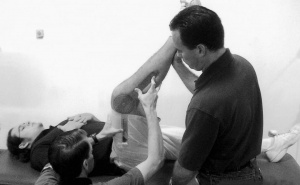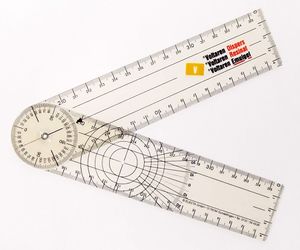Passive Knee Extension Test: Difference between revisions
Tomer Yona (talk | contribs) No edit summary |
No edit summary |
||
| (30 intermediate revisions by 10 users not shown) | |||
| Line 1: | Line 1: | ||
<div class="editorbox"> | <div class="editorbox"> '''Original Editor '''- [[User:Tomer Yona|Tomer Yona]] '''Top Contributors''' - {{Special:Contributors/{{FULLPAGENAME}}}}</div> | ||
'''Original Editor '''- [[User:Tomer Yona| | |||
'' | == Purpose == | ||
</ | [[File:90901.jpg|right|frameless]] | ||
The purpose of the Passive [[Knee]] Extension Test (PKET) is to examine the joint range and its quality of movement; in particular, the '[[End-Feel|end feel]]' of the joint. The test can also measure tightness of the [[Hamstrings|hamstring muscles]].<ref name="fred">Fredriksen H, Dagfinrud H, Jacobsen V, Maehlum S. Passive knee extension test to measure hamstring muscle tightness. Scandinavian journal of medicine & science in sports. 1997 Oct 1;7(5):279-82.</ref> | |||
* Hamstring flexibility measurements are of clinical relevance for the prognosis of [[Hamstring Muscle Strain|hamstring injury]] and for monitoring recovery after such injury.<ref name=":0">Reurink G, Goudswaard GJ, Oomen HG, Moen MH, Tol JL, Verhaar JA, Weir A. [https://journals.sagepub.com/doi/10.1177/0363546513490650 Reliability of the active and passive knee extension test in acute hamstring injuries.] The American journal of sports medicine. 2013 Aug;41(8):1757-61.Available:https://journals.sagepub.com/doi/10.1177/0363546513490650 (accessed 26.10.2021)</ref> | |||
* PKET is used as a criteria for [[Anterior Cruciate Ligament (ACL) Reconstruction|ACL]] return to play from phase 1 (wk 1-4) to phase 2 (week 4-8) .<ref>Norton Sports performance [https://nortonsportsperformance.com/wp-content/uploads/Return-To-Play-Knee-2020.pdf Return to play] https://nortonsportsperformance.com/wp-content/uploads/Return-To-Play-Knee-2020.pdf (accessed 26.10.2021)</ref><br> | |||
== Technique< | == Technique == | ||
[[File:Medizinischer Goniometer.jpg|right|frameless]] | |||
The patient is positioned in [[Cardinal Planes and Axes of Movement|supine]] with the [[hip]] of the tested leg in 90 degrees of flexion.The contralateral leg stays flat on the examination table. The clinician extends the knee until reaching the maximal tolerable stretch of the hamstring muscle as indicated by the patient with the ipsilateral hip remaining in 90 of flexion. The knee angle is then measured with a [[goniometer]].<ref name="reur">Reurink G, Goudswaard GJ, Oomen HG, Moen MH, Tol JL, Verhaar JA, Weir A. Reliability of the active and passive knee extension test in acute hamstring injuries. The American journal of sports medicine. 2013 Aug 1;41(8):1757-61.</ref> | |||
The | Goniometer Placement: The Axis of the goniometer should be places at the lateral epicondyle of the [[femur]]. The moving arm should point towards the lateral malleolus and the stationary should point towards the greater trochanter.<ref name="rees">Reese NB, Bandy WD. Joint range of motion and muscle length testing. Elsevier Health Sciences; 2016 Mar 31.</ref><ref name="nels">Nelson RT, Bandy WD. Eccentric training and static stretching improve hamstring flexibility of high school males. Journal of athletic training. 2004 Jul 1;39(3):254.</ref> | ||
== | == Normal Test Values == | ||
Davis et al<ref name="davis">Davis DS, Quinn RO, Whiteman CT, Williams JD, Young CR. Concurrent validity of four clinical tests used to measure hamstring flexibility. The Journal of Strength & Conditioning Research. 2008 Mar 1;22(2):583-8.</ref> found the normal values (in degrees)of the [[Popliteal Fossa|popliteal]] angle (180 degrees - knee extension angle) in a population of healthy college student to be as follows: | |||
{| cellspacing="1" cellpadding="1" border="1" width="200" | |||
|- | |||
| Men | |||
| Women | |||
| Mean | |||
|- | |||
| 71.6 | |||
| 77.7 | |||
| 74.6 | |||
|} | |||
== Reliability == | |||
The [[Active Knee Extension Test|active knee extension test]] (AKET) and passive knee extension test (PKET) are proven to be reliable in healthy subjects<ref name=":0" /> | |||
The Passive Knee ExtensionTest has good intra-tester reliability [ICC: 0.97-0.98].<ref>Youdas JW, Krause DA, Hollman JH, Harmsen WS, Laskowski E. The Influence of Gender and Age on Hamstring Muscle Length in Healthy Adults. Journal of Orthopaedic & Sports Physical Therapy 2005:35:246-252</ref> | |||
== References == | |||
< | |||
</ | |||
== References | |||
<references /> | <references /> | ||
[[Category:Special_Tests]] | |||
[[Category:Knee]] | |||
[[Category:Knee - Assessment and Examination]] | |||
[[Category:Knee - Special Tests]] | |||
Latest revision as of 06:07, 26 October 2021
Purpose[edit | edit source]
The purpose of the Passive Knee Extension Test (PKET) is to examine the joint range and its quality of movement; in particular, the 'end feel' of the joint. The test can also measure tightness of the hamstring muscles.[1]
- Hamstring flexibility measurements are of clinical relevance for the prognosis of hamstring injury and for monitoring recovery after such injury.[2]
- PKET is used as a criteria for ACL return to play from phase 1 (wk 1-4) to phase 2 (week 4-8) .[3]
Technique[edit | edit source]
The patient is positioned in supine with the hip of the tested leg in 90 degrees of flexion.The contralateral leg stays flat on the examination table. The clinician extends the knee until reaching the maximal tolerable stretch of the hamstring muscle as indicated by the patient with the ipsilateral hip remaining in 90 of flexion. The knee angle is then measured with a goniometer.[4]
Goniometer Placement: The Axis of the goniometer should be places at the lateral epicondyle of the femur. The moving arm should point towards the lateral malleolus and the stationary should point towards the greater trochanter.[5][6]
Normal Test Values[edit | edit source]
Davis et al[7] found the normal values (in degrees)of the popliteal angle (180 degrees - knee extension angle) in a population of healthy college student to be as follows:
| Men | Women | Mean |
| 71.6 | 77.7 | 74.6 |
Reliability[edit | edit source]
The active knee extension test (AKET) and passive knee extension test (PKET) are proven to be reliable in healthy subjects[2]
The Passive Knee ExtensionTest has good intra-tester reliability [ICC: 0.97-0.98].[8]
References[edit | edit source]
- ↑ Fredriksen H, Dagfinrud H, Jacobsen V, Maehlum S. Passive knee extension test to measure hamstring muscle tightness. Scandinavian journal of medicine & science in sports. 1997 Oct 1;7(5):279-82.
- ↑ 2.0 2.1 Reurink G, Goudswaard GJ, Oomen HG, Moen MH, Tol JL, Verhaar JA, Weir A. Reliability of the active and passive knee extension test in acute hamstring injuries. The American journal of sports medicine. 2013 Aug;41(8):1757-61.Available:https://journals.sagepub.com/doi/10.1177/0363546513490650 (accessed 26.10.2021)
- ↑ Norton Sports performance Return to play https://nortonsportsperformance.com/wp-content/uploads/Return-To-Play-Knee-2020.pdf (accessed 26.10.2021)
- ↑ Reurink G, Goudswaard GJ, Oomen HG, Moen MH, Tol JL, Verhaar JA, Weir A. Reliability of the active and passive knee extension test in acute hamstring injuries. The American journal of sports medicine. 2013 Aug 1;41(8):1757-61.
- ↑ Reese NB, Bandy WD. Joint range of motion and muscle length testing. Elsevier Health Sciences; 2016 Mar 31.
- ↑ Nelson RT, Bandy WD. Eccentric training and static stretching improve hamstring flexibility of high school males. Journal of athletic training. 2004 Jul 1;39(3):254.
- ↑ Davis DS, Quinn RO, Whiteman CT, Williams JD, Young CR. Concurrent validity of four clinical tests used to measure hamstring flexibility. The Journal of Strength & Conditioning Research. 2008 Mar 1;22(2):583-8.
- ↑ Youdas JW, Krause DA, Hollman JH, Harmsen WS, Laskowski E. The Influence of Gender and Age on Hamstring Muscle Length in Healthy Adults. Journal of Orthopaedic & Sports Physical Therapy 2005:35:246-252








